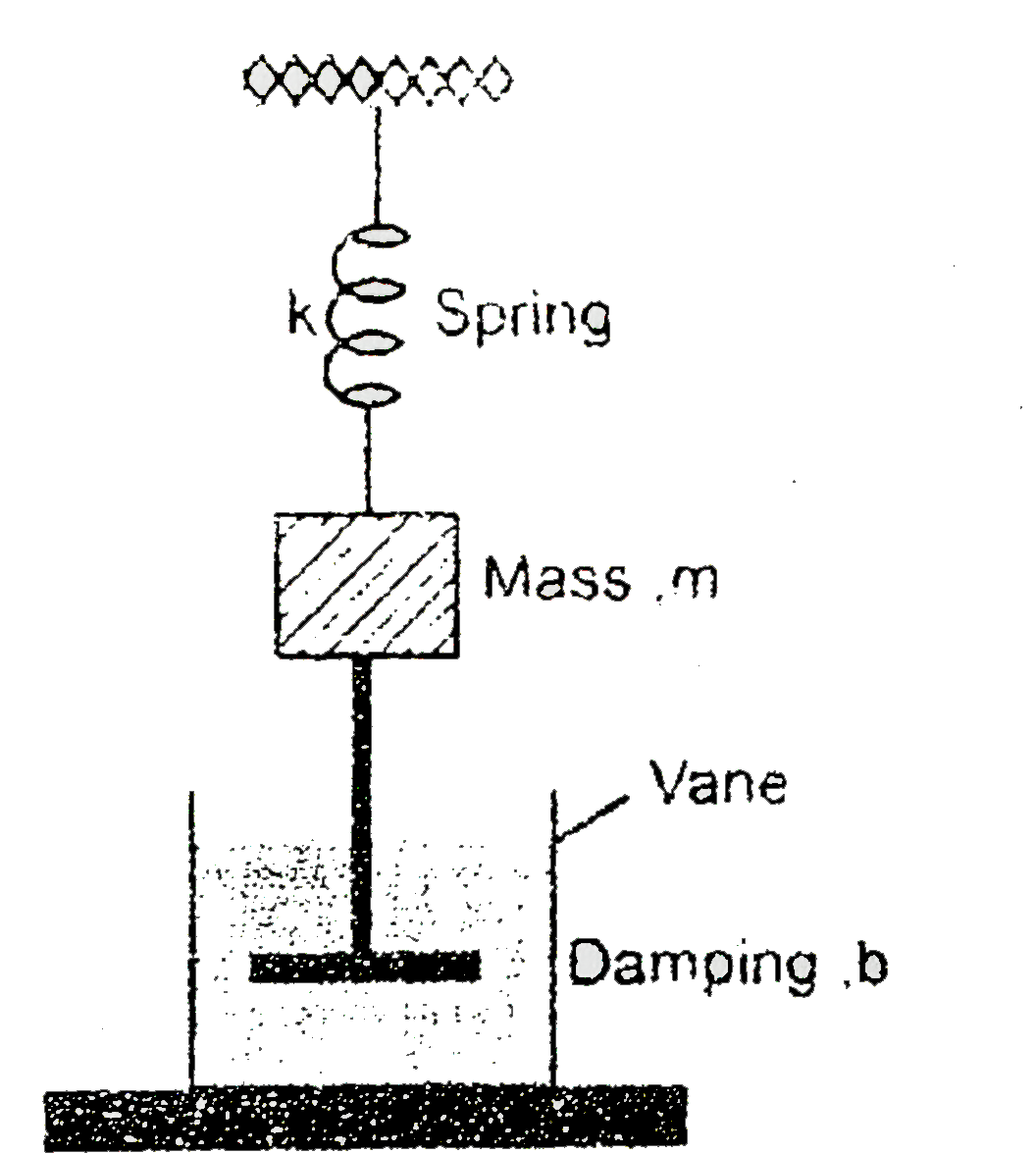Amplitude of mass spring system which is executing SHM decreases with time. If mass = 500g decay constant = 20 g/s then how much time is required for the amplitude of the system to drop to half of its initial value.
15.01s
17.32s
14.65s
34.66s
To solve the problem of how much time is required for the amplitude of a mass-spring system executing simple harmonic motion (SHM) to drop to half of its initial value, we can follow these steps:
1. Understanding the Problem:
The amplitude A(t) of a damped harmonic oscillator decreases over time according to the formula:
A(t)=A0e−V2mt
where A0 is the initial amplitude, V is the damping constant, m is the mass, and t is time.
2. Given Values:
- Mass m=500g=0.5kg (since we need to convert grams to kilograms for standard SI units)
- Damping constant V=20g/s=0.02kg/s (again converting grams to kilograms)
3. Setting Up the Equation:
We want to find the time t when the amplitude A(t) is half of its initial value A0:
A(t)=A02
Substituting this into the amplitude equation gives:
A02=A0e−V2mt
4. Canceling A0:
Since A0 is present on both sides, we can cancel it out:
12=e−V2mt
5. Taking the Natural Logarithm:
Taking the natural logarithm of both sides:
ln(12)=−V2mt
6. Substituting Values:
Now substitute V=0.02kg/s and m=0.5kg:
ln(12)=−0.022×0.5t
Simplifying the right side:
ln(12)=−0.021t=−0.02t
7. Calculating t:
Rearranging gives:
t=−ln(12)0.02
We know that ln(12)=−ln(2), so:
t=ln(2)0.02
8. Finding ln(2):
The value of ln(2) is approximately 0.693:
t=0.6930.02=34.65seconds
Final Answer:
The time required for the amplitude of the system to drop to half of its initial value is approximately 34.65seconds.
---
The amplitude A(t) of a damped harmonic oscillator decreases over time according to the formula:
A(t)=A0e−V2mt
where A0 is the initial amplitude, V is the damping constant, m is the mass, and t is time.
- Mass m=500g=0.5kg (since we need to convert grams to kilograms for standard SI units)
- Damping constant V=20g/s=0.02kg/s (again converting grams to kilograms)
We want to find the time t when the amplitude A(t) is half of its initial value A0:
A(t)=A02
Substituting this into the amplitude equation gives:
A02=A0e−V2mt
Since A0 is present on both sides, we can cancel it out:
12=e−V2mt
Taking the natural logarithm of both sides:
ln(12)=−V2mt
Now substitute V=0.02kg/s and m=0.5kg:
ln(12)=−0.022×0.5t
Simplifying the right side:
ln(12)=−0.021t=−0.02t
Rearranging gives:
t=−ln(12)0.02
We know that ln(12)=−ln(2), so:
t=ln(2)0.02
The value of ln(2) is approximately 0.693:
t=0.6930.02=34.65seconds
The time required for the amplitude of the system to drop to half of its initial value is approximately 34.65seconds.
Topper's Solved these Questions
- JEE MAIN 2021BOOK - JEE MAINS PREVIOUS YEARCHAPTER - JEE MAIN 2021EXERCISE - SECTION-A
80 Videos
- JEE MAIN 2021BOOK - JEE MAINS PREVIOUS YEARCHAPTER - JEE MAIN 2021EXERCISE - SECTION-B
40 Videos
- JEE MAINBOOK - JEE MAINS PREVIOUS YEARCHAPTER - JEE MAINEXERCISE - All Questions
473 Videos
- JEE MAIN 2022BOOK - JEE MAINS PREVIOUS YEARCHAPTER - JEE MAIN 2022EXERCISE - Question
492 Videos
Similar Questions
Amplitude of a mass-spring system, which is executing simple harmonic motion decreases with time. If mass=500g, Decay constant=20 g/s then how much time is required for the amplitude of the system to drop to half of its initial value ? (In 2=0.693)
View SolutionFor the damped oscillator of Fig. 15.20, m= 250g, k= 85N/m, and b= 70g/s
How long does it take for the amplitude of the damped oscillations to drop to half its initial value?
View Solution
Knowledge Check
A block off mass 200 g executing SHM under the unfluence of a spring of spring constant k=90Nm−1 and a damping constant gb=40gs−1. The time elaspsed for its amplitude to drop to halff of its initial value is (Given, ln (1/2)=−0.693)
A7sB9sC4sD11sThe half life of a radioactive substance is 20s, the time taken for the sample to decay by 7/8th of its initial value is
A20 sB40 sC60 sD80 sThe amplitude of a particle executing SHM is made three-fourth keeping its time period constant. Its total energy will be
AE2B34EC916EDnone of these
Half life of a sample is 20 minutes. In how much time will the acitivity of sample drop to 1/16 of its initial value?
View SolutionFor a damped oscillator damping constant is 20gm/s, mass is 500gm. Find time taken for the amplitude to become half the initial
View SolutionHow many time constants will elapse before the current in a charging R−C circuit drops to half of its initial value?
View SolutionIn damped oscillatory motion a block of mass 20kg is suspended to a spring of force constant 90N/m in a medium and damping constant is 40g/s. Find (a) time period of oscillation (b) time taken for amplitude of oscillation to drop to half of its intial value (c) time taken for its mechanical energy to drop to half of its initial value.
View SolutionFor the damped oscillator shown in Fig, the mass of the block is 200g,k=80Nm−1 and the damping constant b is 40gs−1 Calculate
(a) The period of oscillation
(b) Time taken for its amplitude of vibrations to drop to half of its initial values
(c) The time for the mechanical energy to drop to half initial values

View Solution
